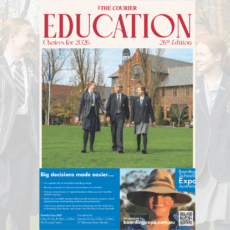The University of Sydney’s Plant Breeding Institute is always a hive of activity as researchers undertake projects to make the lives of farmers easier, helping to keep their operations efficient and productive.
There are many benefits to having a Narrabri base including the real-life connections and feedback researchers get straight from the mouths of locals in the agricultural industry.
And with heat stress estimated to cost the grains industry $37 million annually in wheat alone, researchers have been working hard to find away to prevent the damaging impacts of a hot finish on a bumper crop.
“In a nutshell, we are searching the world for wheat that is considerably more tolerant to heat than our current Australian varieties and developing a way for breeders to speed up the selection process when working with the heat tolerance trait,” said Dr Rebecca Thistlethwaite, an agricultural scientist at The University of Sydney’s PBI.
“This research came about as a direct result of grower feedback as growers in our area and across the world are experiencing terminal heat events during key growth stages.
“There’s only so much a grower can achieve by manipulating sowing time and if there’s not enough moisture early in the season then they would have no choice but to wait to plant.
“By providing genetically superior wheat varieties that are able to tolerate heat, a grower has much more flexibility and can be confident that their crop will hold up should a terminal heat event occur.
“By combining a strategically planted crop with genetic superiority then the grower has covered most bases should a trying year unfold.
“A changing climate will have dire impacts on agriculture in our region and if we intend to be able to feed an ever-growing population with less than we ever had before then breeding heat tolerance into our crops is one way of achieving this.”
The Grains Research and Development Corporation has invested in research to improve the heat tolerance of wheat varieties and maximise yield potential in a warmer climate.
The $4 million collaborative project with the University of Sydney, InterGrain, Agriculture Victoria and the Western Australian Department of Primary Industries and Regional Development, proposes to deliver a minimum of five adapted wheat pre-breeding lines with at least 10 per cent higher yield than the current highest yielding cultivars under heat stress during grain filling by 2026.
Dr Thistlethwaite said the project used a three-tiered approach to screen large numbers of materials, mainly in the field.
“We are lucky enough to work with many different organisations who allow us to import new genetic material and then we test them head-to-head in field trials here in Narrabri and at selected key sites across Australia.
“The majority of success when breeding for any type of trait comes down to high numbers of appropriately selected lines, screened at diverse locations over multiple years and this is how we have been able to ensure that we are getting the best representation of the material that we are testing.
“To confirm the tolerance of the most successful lines in the field trials to heat, we place a polycarbonate covered steel frame attached to a reverse cycle air conditioner over these lines while they are in their natural field environment and increase the temperature even further.
“Those that do well under these units, go into a traditional glasshouse environment for further validation.
“This three-tiered approach to phenotyping (which is just a fancy word for looking at the characteristics of a plant) allows us to ensure we are getting a true and repeatable result.”
As The University of Sydney implements a pre-breeding program to identify genotypes with high and repeatable heat tolerance, Dr Thistlethwaite said it was rewarding to be part of a team that’s working to secure sustainable food production, both domestically and internationally, “whatever the future climate may throw at us”.
“Our team has the interests of breeders and growers foremost in our minds when carrying out this research.
“This means that when we go about selecting lines that are more heat tolerant, they also need to out yield common commercial varieties at a normal planting date for the location and not succumb to any type of disease during the season.
“Heat tolerance and traits that infer high yield have a complex genetic makeup so we also physically combine the genetics of lines that do well by crossing one with the other in the hope that we will achieve a cumulative gene effect.
“We then put them through the same rigorous, three-tiered screening process.
“This has created valuable material which has been disseminated to breeding companies to use within their programs.”
La Nina’s lashing rains and floodwaters in 2022 meant many farmers required heat to get waterlogged winter crops to the point of harvest.
“Last year threw all of us a curveball. Like most growers, we struggled to get into the field on foot let alone get the heat that we needed to really test our material.
“However, future climate predictions say that we are still going to have very hot weather and even when water is plentiful to a crop it could still struggle to cope with a heat wave a critical growth stage.
“So that we don’t confound the results, we make sure that our trials are all well-watered each season so that it’s heat tolerance we’re getting and not drought tolerance.”
Dr Thistlethwaite, who is also an active member of the Narrabri community, said PBI’s regional location provided her with a fantastic and unique opportunity to carry out her work as an agricultural scientist.
“We are extremely lucky as an industry to have a site like the Plant Breeding Institute because there are very few sites worldwide with such clean, consistent land to plant field trials.
“Of course, you need the staff to go along with this and we would be absolutely lost without the farm staff who carefully look after all of our precious trials each year to ensure researchers like me, get the best result we can for our relative funding bodies.”
“On top of this, we’ve recently had world-class teaching and laboratory facilities built to complement the field work.
“However, the best and most important thing about this institute being based in Narrabri is the fact that we are in the heart of prime cropping country and have close contact with local growers and advisors whose regular conversations are what keep our research grounded and relevant.
“The next step for us, I think, is to look at the combination of heat, drought stress and what happens when we also begin to increase atmospheric CO2.
“A very complex experiment to try to achieve in a field environment (rather than a glasshouse) so hopefully we can make this happen.”
To order photos from this page click here









